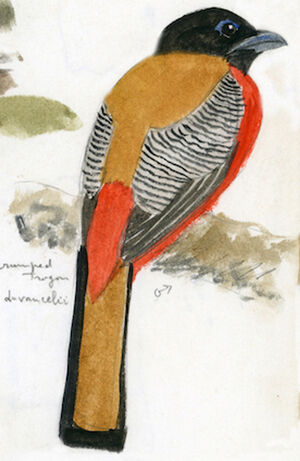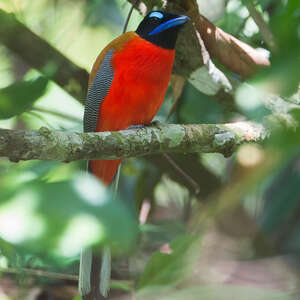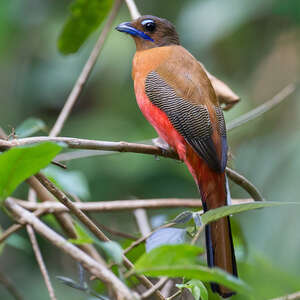Scarlet-rumped Trogon
Harpactes duvaucelii - Trogon de Duvaucel
Identification
Scarlet-rumped Trogon, or the trogon of Duvaucel, owes its name to Alfred Duvaucel, a French naturalist (1793-1824) who travelled to India from 1817 until his death in Madras. Conrad Jacob Temminck, a Dutch ornithologist (1778-1858), catalogued Harpactes duvaucelii and gave it this name in honour of Alfred Duvaucel's work. Measuring 23 to 24 cm, this Scarlet-rumped Trogon is among the smaller trogonids, with a black head, cap, nape and throat, a sky-blue beak with a black tip, and a broad sky-blue eyebrow. The distinctive markings continue with a scarlet chest and belly; the mantle and upper back are cinnamon-brown in colour; and the rump holds onto the scarlet hue of the belly. The black coverts are finely flecked with vagues of white, and the black tail feathers have thin white margins. The upper central retrices are cinnamon-brown barred with black at their extremity, with the external retrices being black but scarcely visible. The lower retrices are white, lightly horizontally striped with black in the middle, and as the bird spreads out its retrices they will expose their black upper external retrices, the tail becoming entirely black in the centre and white on the outside. Female Scarlet-rumped Trogon has a olive-brown head, differing from female cinnamon trogon who has a rufous eye frame and parotid, a buff-pink breast which turns into an orange-red belly, a very light chestnut-brown mantle and back which takes on a pinkish hue on the rump; and its dark brown coverts with large buff-pink horizontal vermiculations.The upper central tail feathers are reddish-brown while the lower white tail feathers are black-gray at their base. The tarses have a bluish-gray coloration. Juveniles have a general light brown coloration, the coverts have coarse vermiculations, the young males in particular, do not yet have the fineness of adults.
Subspecific information monotypic species
Foreign names
- Trogon de Duvaucel,
- Trogón culirrojo,
- republicano-de-rabadilha-vermelha,
- Rotbürzeltrogon,
- Roodrugtrogon,
- Trogone groppascarlatta,
- rödgumpad trogon,
- Rødgumptrogon,
- dravčík malý,
- trogon šarlatový,
- Rødgumpet Trogon,
- punaperätrogoni,
- trogon de carpó escarlata,
- sędzioł czerwonorzytny,
- Красногузый азиатский трогон,
- Luntur putri,
- コシアカキヌバネドリ,
- 红腰咬鹃,
- นกขุนแผนตะโพกแดง,
- 鮮紅腰咬鵑,
Voice song and call
The Scarlet-rumped Trogon launches sharp phrases yau-yau-yau-yau-yuyuyuyuyu repeated, the end of its song rolls high and very quickly. When the bird sings frequently, one can feel like the first phrase isn't finished yet while the second one is starting! The song of the Scarlet-rumped Trogon is somewhat ventriloquist and is difficult to locate. Its alarm call is of the type kir-r-r-r repeated almost softly, often being declared when it takes off.
Habitat
The Scarlet-rumped Trogon is adaptable to different habitats in its range. It can be found in primary or secondary forests, as well as near plantations (especially old rubber plantations) or abandoned gardens. It inhabits deciduous or semi-deciduous forests, staying in the lower levels. Dipterocarp forests common to Indonesia and Malaysia are often its preferred habitat; these forests containing trees sometimes up to 70 metres high, on which it remains on the lower branches. Mangroves are also a habitat in which the Scarlet-rumped Trogon is visible. In Thailand it remains at low altitudes, but up to 1000 metres in the Malay Peninsula and on the lower slopes of Mount Kinabalu in Borneo at 1500 metres.
Behaviour character trait
Sedentary, some movements have been observed in Borneo without being able to confirm a regular migration.
Dietfeeding habits
Mainly insectivorous, phasmids: caterpillars, butterflies (especially moths), various orthopterans. Sometimes seen with other birds in shrubby areas where it hunts perched at low height. It is known to vary its menu with various seeds as well.
Reproduction nesting
Reproduction period identified from March to May in the Malay Peninsula, where a nest was found at 1. m from the ground in a tree of around 2.50 m tall. In Borneo, in the north of the Kalimantan Oriental province, French naturalist Pierre Pfeffer observed in 1960 small groups of males vocalizing on low branches intimidating each other. Pierre Pfeffer and Australian ornithologist Joseph M. Forshaw thought these demonstrations were similar to the Scarlet-rumped Trogon's from Africa. The clutch had two eggs but there is no information about incubation, feeding and fledging of the chicks.
Geographic range
Many countries host the Scarlet-rumped Trogon: the Malay Peninsula, south of Myanmar (Burma) and Thailand, the Riau Archipelago in Indonesia south of Singapore, Sumatra, the Batu Islands (east of Sumatra), the island of Bangka (west of Sumatra), the island of Belitung (between Sumatra and Borneo), and finally Borneo.
Threats - protection
IUCN conservation status
concern
in the Wild
threatened
evaluated
N.T. Deforestation in all the regions where the Scarlet-rumped Trogon is present puts this brightly-coloured bird in precarious balance. It is rare in Thailand, but more common in Malaysia and Borneo, national parks and nature reserves protect it to some extent, but for how long?
Sources of information
- IOC World Bird List (v15.1), Gill, F and D Donsker (Eds). 2025-12-07.
- A Natural history of the Trogonidae, Joseph M.Forshaw Albert Earl Gilbert
- Vol. 6 - Handbook of the Birds of the World, Josep del Hoyo-Andrew Elliott-Jordi Sargatal
- Scientific Birds Names, James A.Jobling
- xeno-canto, Sharing bird sounds from around the world,
- BirdLife International, BirdLife International
- HBW Alive,
- The internet Bird Collection,
- Wikipédia, Wikipedia, The Free Encyclopedia
- ARKive, Christopher Parsons
Other sources of interest
 Specification sheet created on
04/08/2023 by Anne et Gabriel Leboff
Specification sheet created on
04/08/2023 by Anne et Gabriel LeboffTranslation by AI Oiseaux.net
© 1996-2025 Oiseaux.net
- Accipitriformes
- Aegotheliformes
- Anseriformes
- Apodiformes
- Apterygiformes
- Bucerotiformes
- Caprimulgiformes
- Cariamiformes
- Casuariiformes
- Charadriiformes
- Ciconiiformes
- Coliiformes
- Columbiformes
- Coraciiformes
- Cuculiformes
- Eurypygiformes
- Falconiformes
- Galliformes
- Gaviiformes
- Gruiformes
- Leptosomiformes
- Mesitornithiformes
- Musophagiformes
- Nyctibiiformes
- Opisthocomiformes
- Otidiformes
- Passeriformes
- Pelecaniformes
- Phaethontiformes
- Phoenicopteriformes
- Piciformes
- Podargiformes
- Podicipediformes
- Procellariiformes
- Psittaciformes
- Pterocliformes
- Rheiformes
- Sphenisciformes
- Steatornithiformes
- Strigiformes
- Struthioniformes
- Suliformes
- Tinamiformes
- Trogoniformes








